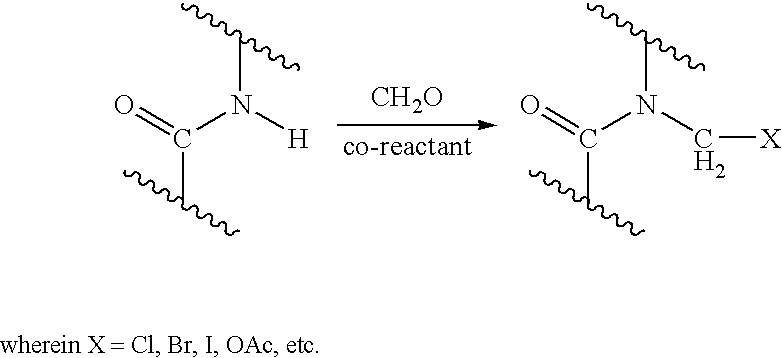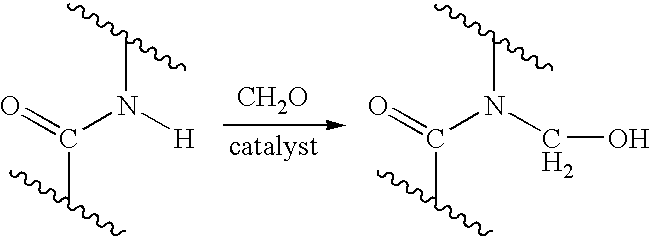Process for providing antimicrobial surfaces
a technology of antimicrobial surfaces and polymer chemistry, which is applied in the direction of biocides, impression caps, catheters, etc., can solve the problems of eliciting irritation, affecting the antimicrobial effect, and the use of these coatings, especially on medical devices, to achieve a durable antimicrobial surface
- Summary
- Abstract
- Description
- Claims
- Application Information
AI Technical Summary
Benefits of technology
Problems solved by technology
Method used
Image
Examples
example 1
[0073]This example illustrates the formation of an antimicrobial surface on a polycarbonate polyurethane (PC-PU) copolymer film substrate using paraformaldehyde and chlorotrimethylsilane to provide the chemically modified surface.
[0074]PC-PU films (2×2 cm, 1 mil thickness, ChronoFlex® C, available from CardioTech International, Inc. Wilmington, Mass.) were immersed in a stirred suspension of paraformaldehyde (0.75 g) and chlorotrimethylsilane (7.2 g). The suspension was heated to 50° C. for 1 h with stirring under reflux. The mixture was allowed to cool. The films were removed and washed, consecutively, with acetonitrile, isopropanol, and distilled deionized (dd) water, each solvent 3 times with 5 mL portions, for 5 min with agitation on a laboratory shaker (135 rpm). The films were dried in a vacuum at 60° C. for 1 h.
[0075]The chemically modified PC-PU films were immersed in anhydrous acetonitrile (5 mL); antimicrobial peptide P50 (SEQ ID NO: 6: VAKKLAKLAKKLAKLAL-CONH2), 3 mg, avai...
example 2
[0076]This example illustrates the formation of an antimicrobial surface on PC-PU coupon substrates (ChronoFlex® C, available from CardioTech International, Inc. Wilmington, Mass.) using paraformaldehyde and chlorotrimethylsilane to provide the chemically modified surface and P50 peptide to provide the antimicrobial surface.
[0077]PC-PU coupons (1.3 cm diameter, 0.3 cm thickness; ChronoFlex® C, available from CardioTech International, Inc. Wilmington, Mass.) were treated with paraformaldehyde (2.5 g) and chlorotrimethylsilane (28 mL) as in example 2 with the exception that 30 mL portions of solvent were used in the wash to provide tacky pale yellow chemically modified surfaces. The chemically modified PU coupons were immersed in three different solutions of anhydrous acetonitrile (4.85, 4.95, and 4.985 mL, respectively) and triethylamine (10 μL) and the following series of P50 stock solution (20 mg / mL in dimethylformamide) added:
[0078]2A—0.15 mL to provide 3 mg P50,
[0079]2B—0.05 mL t...
examples 2d and 2e (comparative)
[0082]This example illustrates the lack of efficacy of PC-PU coupons without the chemical modification, but in the presence of an antimicrobial peptide P50.
[0083]PC-PU coupons (ChronoFlex® C) were immersed in two different solutions of anhydrous acetonitrile (4.85 and 4.985 mL, respectively) and triethylamine (10 uL) and the following series of P50 stock solution (20 mg / mL in dimethylformamide) added:
[0084]2D—0.15 mL to provide 3 mg P50,
[0085]2E—0.015 mL to provide 0.3 mg P50
[0086]The resulting cloudy mixtures were heated to 50° C. and shaken for 1 hour. The PC-PU coupons were allowed to cool for 15 min, The coupons were washed as in example 1, and vacuum dried (50° C., 1 h).
PUM
 Login to View More
Login to View More Abstract
Description
Claims
Application Information
 Login to View More
Login to View More - R&D
- Intellectual Property
- Life Sciences
- Materials
- Tech Scout
- Unparalleled Data Quality
- Higher Quality Content
- 60% Fewer Hallucinations
Browse by: Latest US Patents, China's latest patents, Technical Efficacy Thesaurus, Application Domain, Technology Topic, Popular Technical Reports.
© 2025 PatSnap. All rights reserved.Legal|Privacy policy|Modern Slavery Act Transparency Statement|Sitemap|About US| Contact US: help@patsnap.com



